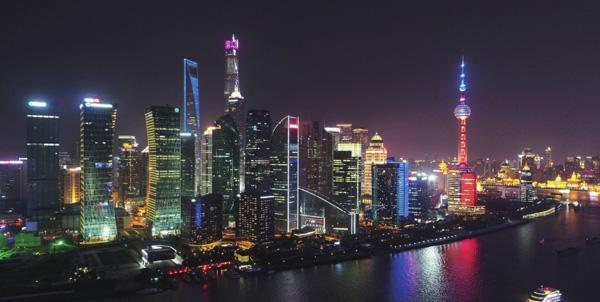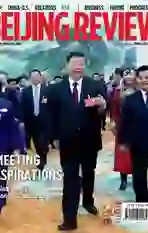Far-Reaching Freedom And Increased Prosperity
2018-04-08

China has experienced great changes and made remarkable progress in many ways since the reform and opening-up policy was adopted 40 years ago in 1978. Helmut Matt, a German writer and expert on China, shares his views on what the far-reaching policy means for China. Excerpts of his article follow:
With todays China, we are looking at an upand-coming, dynamic and rapidly developing country whose economic power has become a global benchmark. Cutting-edge Chinese technologies increasingly occupy the world market, Chinese consumer goods have become an integral part of the worlds shopping centers, and Chinese travelers dominate the tourism sector.
What seems quite natural today was inconceivable just a generation ago. I personally encountered someone from China for the fi rst time in the mid-1980s. It was only a few years earlier that the country, which was previously sealed off, had begun to open up cautiously to the outside world and to introduce important reforms at home. In this context, some Chinese students were allowed to travel abroad for ex- change programs.
The friendly young student who I met at my university in Germany at that time was Li Jie. She had come to Germany to learn German for one semester at the Faculty of Economics at the University of Freiburg. Despite the language barrier, we had many good conversations. It was quite exciting for me to learn first-hand about life in China. Li Jie, on the other hand, was curious to fi nd out more about people in Germany.
I remember that she once gave me a tiny red tin of cold medicine, which has long since been used up. However, I have kept the small container as a souvenir to this day.
These were eventful times when, from December 18 to 22 in 1978, delegates met in Beijing for the Third Plenary Session of the 11th Central Committee of the Communist Party of China (CPC). The decisions made then had such far-reaching consequences that historians sometimes speak of a “new revolution” or a“second revolution.” We are, of course, talking about the introduction of the reform and opening-up policy.
The central themes of the plenary session in 1978 were the emancipation of the mind and the shifting of the national focus to economic development. The reform and opening-up policy was fi rst proposed at this session. Specifi cally, the term “reform and opening up” referred to two important policy areas: internal reforms within China itself and the active external opening of Chinas markets to the rest of the world. The reforms at home were intended to change the economic system and other parameters that in the past had impeded the development of Chinas productive forces.
As a fi rst step toward opening up, the new state leadership initiated the establishment of four special economic zones, with Shenzhen being the most famous example. The plan was to open up coastal, riverine and border areas in the following decades, reaching full participation in economic globalization in the 21st century.
Reform and opening up meant primarily turning away from class struggle as a guiding principle and turning toward the countrys economic development as the nations central task.
The reforms introduced at that time indicated the defi nitive renunciation of the Soviet model of a socialist planned economy and marked the shift toward Chinese socialism with the aim of peaceful development and the socialist modernization of the country.
Chinas policy of reform and opening up is inextricably linked to the Chinese leader who initiated the shift from a strictly planned economy to a freer state and a freer economic system, and who is regarded as its principal architect, Deng Xiaoping.
Reformer Deng was not only the father of Chinas opening-up policy. His reforms also built the basis for Chinas breathtaking economic success, and in less than three decades, the country evolved from a poor third world nation to one of the globes foremost economic powers. China had already outperformed Germany in terms of GDP 10 years ago.
Through the policy of reform and opening up, China has freed itself from poverty and stagnation, and transformed itself into a society full of vigor and vitality. Anyone who today walks the streets and squares of Chinese cities and villages will be amazed by the colorful and cheerful life of the Chinese people. The policy of reform and opening up revived Chinese society and restored peoples self-confi dence and pride with growing economic and political successes.
Forty years have passed since the introduction of the reform and opening-up policy. Without Deng Xiaopings bold move, the visible openness in Chinas political and social spheres would not have been possible.
Today a cosmopolitan and diverse society has emerged in China. During my many stays in the country since 2005, I have noticed there is no subject off limits in my discussions with the Chinese people. In fact, I have often been surprised by the passion for debate, creativity and free thinking of many of my interlocutors.
In todays China, you will find prosperity and diversity in the cultural sphere that had been unimaginable a few decades ago. From Peking Opera to experimental theater, from folk songs to classical Chinese and European music, almost every genre is represented in Chinas music sector nowadays. The picture is similarly colorful if we look at the performing arts or literature. In 2009, as the guest country at the renowned Frankfurt Book Fair, China was able to present a huge variety of literary works, in a diverse array of genres and styles.
It is undeniable that there are still large economic and social differences among Chinas provinces, namely the rich east and the relatively underdeveloped west. However, allegations by some Western media outlets that China neglects its western provinces in favor of the east are lacking in foundation.
Without the economic prosperity of the successful coastal regions, it would not have been possible to develop the less developed interior as practiced by the Chinese Government today. There are only very few countries in the world where the government is making such a great effort to level out the disparity in wealth for balanced regional development, as can be seen in China.
The project to revitalize the ancient Silk Road, in which more than 70 states and organizations have been involved so far, will undoubtedly make a signifi cant contribution to Chinas development in all its regions. The Belt and Road Initiative, as the project is known, was initiated in 2013 by Chinese President Xi Jinping during official visits to Central and Southeast Asia. The aim of this project is to widen the scope of Chinas opening up, to intensify its cooperation with other countries on the basis of mutual benefi t and thus to give new impetus to the national and international economy. With the Belt and Road Initiative, China has suc- ceeded not only in continuing its reform and opening-up policy, but also in elevating it to an even higher level.
The latest economic concept of supplyside reform is also to be understood as a continuation of Dengs reform and openingup policy. In his report to the 19th CPC National Congress, Xi stressed that China “should pursue supply-side structural reform as our main task, and work hard for better quality, higher effi ciency, and more robust drivers of economic growth through reform.”
In order to stimulate the economy through innovation, the Chinese Government is making every effort to release new productive forces in Chinese enterprises and improve their competitiveness. Measures have been taken to phase out obsolete means of production and reduce debt, excess production capacity and tax burdens.
In addition, the Chinese Government plans to intensify its active fi scal policy and continue the countrys current prudent monetary policy. The central goal is to optimize the economic structure and hence promote growth and prosperity.
At the opening of the G20 Summit in Hangzhou on September 3, 2016, Xi gave a keynote address entitled “A New Starting Point for Chinese Development, A New Blueprint for Global Growth.”
According to Xi, China stands at a new historic juncture for the deepening of its reforms and the creation of a new driving force for its economic and social development. It is the beginning of a new normal of economic restructuring, an era of profound interaction between China and the rest of the world, and a time to open the country even more extensively.
After 40 years of reform and opening up, one thing remains clear: it is not only the Chinese people who benefi t from the successful implementation of Deng Xiaopings policy, but the whole world.
Today, China has become one of the most important engines of the world economy. While people in Western countries have benefited from Chinese products that are both inexpensive and high in quality, China has become one of the worlds largest and most profitable markets for Western companies. The high level of prosperity that we enjoy today would be unthinkable without Chinas economic power.
Looking back to 1978, the success of Chinas reform and opening-up policy becomes particularly sharp in focus. China has undergone an astonishing transformation from an impoverished country to an extremely dynamic engine of the world economy.
At the G20 Summit in Hangzhou, Xi suggested a Chinese solution to global economic development. According to Xi, China is ready to “work with all parties involved at the G20 Summit in Hangzhou to promote the strong, sustainable, balanced and inclusive development of the world economy.”
